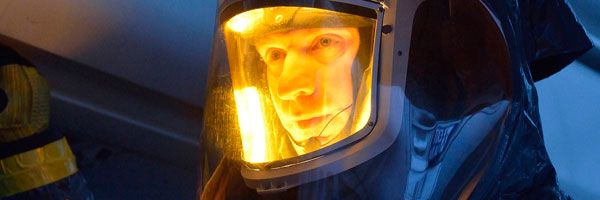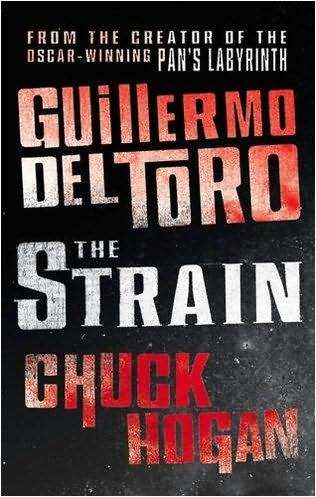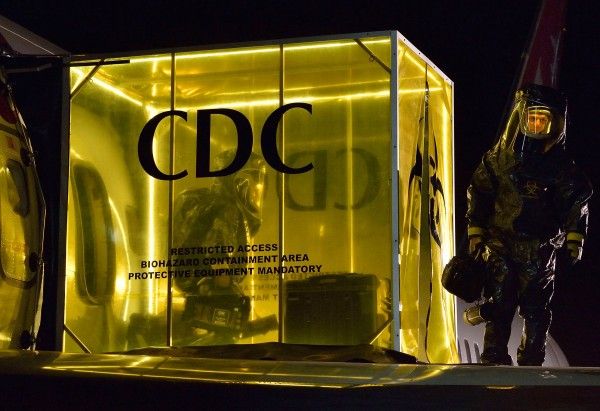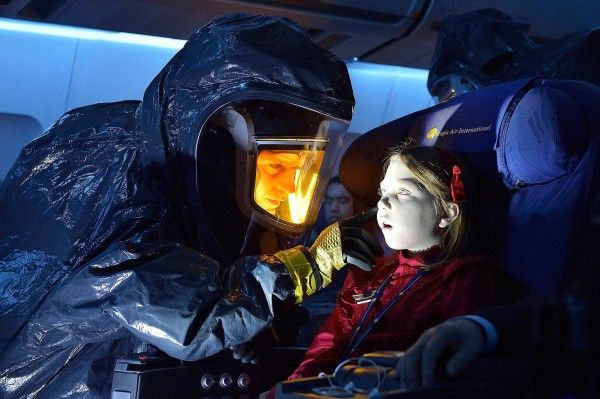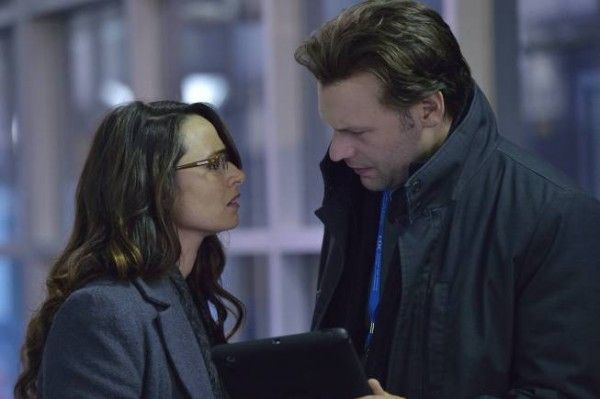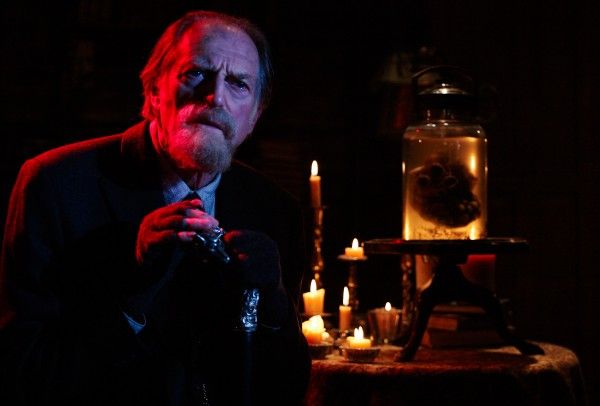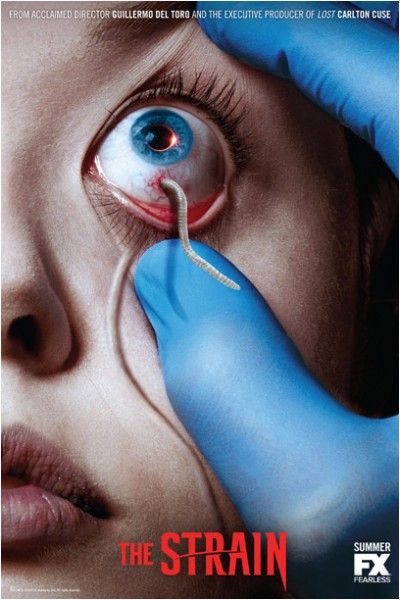From filmmaker Guillermo del Toro and showrunner Carlton Cuse, The Strain tells the story of an epic battle for survival between man and vampire. When Dr. Ephraim Goodweather (Corey Stoll), the head of the Center for Disease Control in New York City, and his team are called upon to investigate a mysterious viral outbreak that is eerily similar to an ancient and evil strain of vampirism, they quickly realize that they are waging war for the fate of humanity itself. The show also stars David Bradley, Mia Maestro, Sean Astin, Jonathan Hyde, Richard Sammel, Miguel Gomez, Natalie Brown and Jack Kesy.
During this recent interview to discuss the show’s premieres, Carlton Cuse and Guillermo del Toro talked about collaborating together, that this is the unadulterated version of the show that they wanted to make, that they basically follow the narrative of the first book in the first season, that they don’t see the series going beyond five seasons, creating the look of the creatures, and how the casting came together. Check out what they said after the jump, and be aware that there are some spoilers.
Question: Carlton, how did you first get involved in this, and what drew you to it?
CARLTON CUSE: I had read the first Strain novel, as a fan of both Guillermo’s work, and I also independently knew Chuck Hogan, so I was very curious to see what this collaboration would look like. I was just intrigued by the subject matter. I had read the first novel when it came out in 2009 and really enjoyed it. And then, about two years ago, my agent called me up and said that there was some interest in doing The Strain as a television series and asked if I would be interested in it. So, I went and met with Guillermo and I had a really good meeting, and I decided to get involved, for two reasons. One, because I had a lot of respect for Guillermo, as a filmmaker, and I thought, particularly in a monster show like this, that he’s one of the most imaginative guys out there, in terms of creating creatures and worlds. And I also thought that embedded in the book was this fantastic opportunity to up-end the vampire genre. The vampire genre has been overrun by romance, and we’ve had our fill of vampires that we’re feeling sorry for because they had romantic problems. It was time to go back to the conception of vampires as really scary, dangerous creatures, and in so doing that, there was a way to make a genre show that would be different than anything that was out there on the TV landscape.
Having done network shows before, has this experience on cable really opened up what you can do with a series, as a producer?
CUSE: Oh, absolutely. I can’t speak broadly to all cable channels, but I will say that FX has been fantastic. And I will say that this show really represents my and Guillermo’s version of the story. It’s really unadulterated. Sure, we can’t drop F-bombs, but that’s about it. We really were able to put our unadulterated version of the story on screen, and FX has been enormously supportive. They’re very aware that when you’re competing with films and also with pay cable, you don’t want to find yourself in a situation where you’re doing an adulterated version of the story. That was something that we were very conscious of and concerned about, and John Landgraf and his team were immensely supportive and really gave us the latitude to tell the story the way we wanted to. It’s got some pretty extreme moments, but I think that that also is what gives the show its octane.
Will each season follow one book?
CUSE: Book 1 is Season 1. We basically follow the narrative of the first book, in the first season. The plan is that the show will run somewhere between three and five seasons. As we work out the mythology and the storytelling for Season 2, we’ll have a better idea of exactly how long our journey is going to be, but it won’t be more than five seasons. We’re definitely writing to an endpoint, and we’re following the path as established in Guillermo and Chuck’s novels, but obviously there’s a lot that’s also going to be added. The television show is its own experience. There are new characters and new situations, and different dramatic developments, so the show and the book can each be separately enjoyed. The goal is not to literally translate the book into a television show. You want to take the book, as a source of inspiration, and then make the best possible television show that you can make. Guillermo, Chuck, myself, and all of us involved have basically said, “Okay, here’s the book. Now, how do we take the best stuff in here, and then use that as elements and make the best TV show that we can.” But we view the TV show as its own creation.
GUILLERMO DEL TORO: And it was very clear, from the start, that we had the three books to plunder, but we also had the chance of inventing. We talked about milestones. We want the milestones and the characters that are in the book to be hit, but with that, it became very malleable. Carlton decided, I think very wisely, in retrospect, to leave the origins of The Master, which we opened Book 1 with, for a second season, if we go that way. It’s a very elastic relationship that the series has with the book, but by that same token, it’s very respectful and mindful of the things that will not alienate someone that likes the books. It should feel seamless. We have to understand that Carlton is guiding us through this new medium for the story, and trust and know that his decisions are guided by huge experience and a prestigious career.
Would you consider extending this series beyond five seasons, if the public response is great?
CUSE: I don’t think so. I think that we’re moving into this new phase of television where audiences are really embracing stories with a beginning, middle, and end. If you look at the success, this season, of True Detective and Fargo, as well as the incredible response that the end of Breaking Bad got, I think that you have to recognize that the audience wants to see stories that come to a conclusion. They want the full and rounded experience. I think that the best television now is giving you a three-act experience, and that’s what we want to do with our show.
DEL TORO: I agree with Carlton. I think one of the things that we made essential when we pitched the series everywhere, and certainly at FX, is that we are not going to be extending beyond the two arcs that we presented, one that can fulfill three or four seasons, and hopefully the second or third book is complex enough that they can generate a fifth one. But we literally said it needs to end when it needs to end, and that was a central part of finding a home for the series.
Guillermo, you directed the pilot, but do you think there’s a chance that you’ll be back to direct any more episodes, in the future?
DEL TORO: It is with both great pleasure and great trepidation that I say that I want to direct the opening one, if there is a second season. And I say trepidation because directing TV is like doing cardio, and if you look at me in any picture, you know I don’t do cardio. But I think that the beauty of the show is that Carlton, Chuck and myself have developed a really good, increasingly fluid relationship. Now and then, in the first season, I would go and shoot additional material with a Saturday second unit, or Carlton and I could increasingly jab each other into coming up with sick ideas, in the middle of the season. I really like that because it is such a pleasurable experience. You come in, and it is incredibly intense on a day-to-day basis because each day on a TV series, it seems like a week on a feature. I have made it a point to stay obsessively involved in supervising every single aspect of the effects on the series, with the make-up effects, color correction, and this and that. This is our baby. It’s like Three Men and a Baby for vampires, and I think that it will be essential for me to continue to be involved, in that way.
Can you talk about creating the look of the creatures?
DEL TORO: In terms of creature creation, we really went into it trying to reveal the biological traits and the design traits of these creatures, so that they make sense to an audience, not just from a looking good point of view, but to make them feel organic, and to make them feel like a different breed in the evolutionary history of this planet. You get to see them as a species, in a way, the more you advance in the plot of this series. So, designing it took approximately six months of just purely conceptual and sculptural and draftsmanship design, and executing it took a very long time. It was as complex and as demanding as designing creatures for a feature film.
How did you decide the powers they would have, the tongues that they have, their appearance, and stuff like that?
DEL TORO: I’ve been obsessed by vampires for a long, long time, since I was a very young, very strange kid. I’ve read about vampire mythology worldwide, and I familiarized myself with the Japanese, Filipino, Malaysian and Eastern European variations on the vampire. I kept very detailed notes, as a kid, on where to go with the vampire myth, in terms of brutality, social structure and biology. Some of those notes made it into my first feature, Cronos, some of them made it into Blade II, when I directed that, and most of them made it into The Strain. And designing them, we had it very clear that The Master needed to be hidden, for at least half of the season or more, to not make him that accessible. And I came up with the idea that this guy that has been alive for centuries and essentially is an apex of the Dark Ages in the middle of a world of imminent modernity. You have people with cell phones, jet airplanes, iPads, texting, Internet, and all of that, and in the middle of that is a 9 foot tall, hand carved coffin with a creature that has been alive for centuries. It’s ancient, and that’s what makes it powerful. It doesn’t care about any of the modern accouterments of mankind, that gives mankind such a false sense of security. And The Master needed to look that ancient, so we decided that he was going to become his wardrobe and that eventually, when he reveals himself, you’ll have a second layer. So, we designed the wardrobe, the cape and the multiple layers of clothes that are falling apart, because he has an accumulation of clothes over the 1800s, 1900s and the 21st century. He’s just accumulating rags, and he needed to look like a bunch of rags thrown on the floor, and out of all these rags comes out this incredibly glistening and viscerally biological appendage that then drains the first victim. That’s the way we started guiding the process of designing The Master. The more we go into the season, the more you see of him and the more you discover layer after layer of that creature design.
And what about the other characters?
DEL TORO: Well, the longer the vampires stay alive, the more they lose their humanity. They start by literally losing their heart. Their heart is suffocated by a vampire heart that overtakes the functions. That was important, metaphorically, for me because the beacon that guides these vampires to their victims is love. They go to the people they love the most. So, they turn the instinct that is most innately human into the most inhuman feeding mechanism. Their heart is dead. Then, shortly thereafter, their digestive system is overtaken and their genitals fall off. Their excretion system becomes really, really efficient, in the way that ticks or lower forms of life that feed on blood do. In the series, that comes with big splashes of ammonia-infused liquid that they expel while they’re feeding. And then, they lose their soft tissue, and their ears and nose start falling off. If they’ve been alive for several years, their nose rots and falls away, and they develop a tracheal opening to vent the extra heat from the metabolism and to project the stinger. I took a very biological approach. It’s not just, “Oh, that looks cool.” I wanted to have it make sense, biologically, in the design. They lose their hair because their body heat is so great that it consumes the fat in the scalp and burns the roots, and then they change color because they lose their red cells.
Where there elements within the book that you wanted to preserve for the book experience and keep as a unique experience to that medium?
CUSE: No, I don’t think so. There was a lot of conversation about what to translate. We never discussed preserving something for the books. The experience of reading a book is always unique. I believe that you render a version of the story, when you read a book, in a way that is unique and special to each person who reads it. And I think the experience of reading these books is going to be always separate from what the show’s going to be like. My approach with the series was, “Let’s take the best of what was in the books and figure out how we can translate that into the scripted form and make that into the best version of a TV series.” In many cases, it was also, “Okay, here’s an idea that’s in this book that’s really great. How do we actually embellish this? How do we take this and make this into even more of a story?” So, the books remain an incredible source of departure and inspiration. It’s a very artistic process to translate and adapt a book into a series, and I think we really felt, very early on, that the two just had to be their own thing. We used the books as far as we could, and then we would add stuff as it made sense.
DEL TORO: Obviously, we have to choose what stories and what quirks you tell and not tell from the book. There are, believe it or not, far more disturbing moments in the book, here and there, than there are in the series. They would be almost unbearable, if you were going to stage them the way they are described in the book. So, believe it or not, we did exercise restraint.
How did this casting come together?
CUSE: Guillermo and I cast the entire show together, over almost a year. It was another one of those advantages of having a lot of time to prep the show. We had a lot of time to thoughtfully consider who was going to be in our cast. Also, we have to give a lot of credit to our wonderful casting director, who cast Lost. She has wonderful taste and a wonderful ability to find actors. We met a lot of actors and we spent a lot of time discussing and considering who would be right for these roles. It’s just a hugely important part of the process. I used to have a lot more hubris about the power of writing, and that it would conquer all, but I don’t anymore. I really think that as good of a job as you do as a writer, you’re absolutely indebted to the actors that have to deliver that material. And we were incredibly fortunate to get some wonderful name actors, like Corey Stoll, but to also find some amazing discoveries like Miguel Gomez and Richard Sammel.
DEL TORO: In the case of two or three of the parts, we didn’t cast a wide net. We knew who we wanted, and when we met those actors, we proceeded to offer them the role, right there on the first meeting. In the case of Sean Astin, we said, “I think his character and the turn of his character is really feeding on his persona and his baggage, in a great way.” He’s so reliable and so adorable, but his character has to do things that are ambivalent. In the case of Corey, we were completely in sync with the casting.
Will David Bradley’s character become more involved in the narrative, as time goes on?
CUSE: Part of the fun of the way that the storytelling is structured is that this mosaic of characters that we’re following are going to cross and connect to each other. We spent a lot of time in the writers’ room, figuring out at what point we were going to have these characters intersect and how they were going to intersect. So, yes, David Bradley is a huge part of the show. He’s a wonderful actor. Guillermo and I wanted a guy who wasn’t going to be the sweet, kindly, grandfather, mentor figure that we’ve seen in a lot of shows. We wanted Setrakian to be a bad-ass, and David Bradley was the perfect piece of casting. He plays a hugely significant role in the series.
DEL TORO: It was clear from the start that we didn’t want the wise, gentle, father-figure mentor. We wanted a guy that had a lot of edges and that became a bristling hub for all the characters. Every character ends up circulating around the figure of Setrakian. Corey and Mia’s characters connect with the rest of the characters through Setrakian. And what we did that I enjoy a lot is that we have false crossings of characters. Characters meet briefly, but they don’t have to come together yet. That is the case clearly with Miguel’s character, Gus, who meets two of our main characters, and yet he doesn’t become one of the gang right away. I think that’s really nice. But Setrakian is the one element of the show that goes through the mythology of the ancient and the modern, but brings a very, very hard edge to the figure of the man who knows. He’s not whimsical. He’s impulsive, aggressive and really edgy, and is capable of big, great, sweeping actions. David is the most vital guy, regardless of his chronological age, and he has incredible vitality. That feeds into the role.
Guillermo, what’s it like for you to see this story, that you’ve worked on and you had on the page, come to life on the screen?
DEL TORO: It was really beautiful to go through the process with new partnerships. I think that it’s great to do it with a partner that has been so close to the books, like Chuck, and someone that seems to have such a strong and revitalizing take as Carlton. I think it has really been quite energizing for me to see that. Carlton and I both come from a world where partnerships are basically a single-minded approach to storytelling. Carlton and myself are used to storytelling in the audio-visual universe in an absolute way, and this partnership has required growth and opening our views. They are enriched by both of us having really strong points of view, which is not unlike the partnership I have with Chuck Hogan. Quite frankly, it has been great to hear, “No,” from Carlton. He’ll say, “No. Now listen, this is why we’re not going to do this.” And I’d say, “Wow, I never thought about it in that way.” The idiosyncrasies of being a filmmaker and director or writer is that you domineer what happens. This is truly one of the most complete collaboration processes I’ve experienced. It’s hard to define where every territory ends, but it’s not hard to know that each of us brings a different strength to the project, and we trust each other. So, that process has been the most beautiful difference between putting the project on the page and seeing it fortify as a series. You don’t exactly land where you thought you would land, but you land on a place that feels incredibly right.
The Strain airs on Sunday nights on FX.

